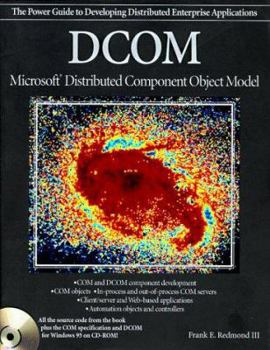Dcom: Microsoft Distributed Component Object Model
Containing explanations and worked examples, this is a concise guide to building distributed applications using Microsoft's Component Object Model. It discusses how to build COM objects and... This description may be from another edition of this product.
Format:Paperback
Language:English
ISBN:0764580442
ISBN13:9780764580444
Release Date:January 1997
Publisher:IDG Books Worldwide,
Length:359 Pages
Weight:1.40 lbs.
Dimensions:8.9" x 1.1" x 7.2"
Customer Reviews
5 ratings
Is COM or DCOM or COM+ still relevant?
Published by Thriftbooks.com User , 21 years ago
The Component Object Model (COM) was introduced by Microsoft in 1993 to solve several problems. The leading problem was the inability to reuse code because class encapsulation was incomplete. Therefore certain implementation details of methods inside a class could inadvertently become exposed and exploited by some users and not by others. This made changing the implementation problematic. The underlying concept of COM is to make it possible to design and deploy software components much as electronic devices can be built from resistors, capacitors and inductors. You can safely replace a resistor of a certain number of ohms with a like resistor and be absolutely certain the replacement resistor will function identically to the replaced resistor. With components that act like black boxes and perform well defined functions in undocumented ways, you are well on your way to having replaceable software components. Next came the problem of versioning where a component would retain all of its previous functionality yet add some new ones. Users of the old version would not enjoy the benefits of the new version yet would function perfectly with the new version. Users of the new version would function with the old version after deciding the new version was unavailable and degrading their expectations. Versioning is carried out through unique 128-bit integer identifiers called Globally Unique IDs. Then COM goes a bit crazy with concepts like apartments and non-stack, non-heap special memory areas for passing across communications link and special types called variants that must be used in place of familar types. For example, a CString becomes a BSTR in COM. A COM object is instantiated through a special API call which returns a pointer to an interface through which other methods can be located and called. The housekeeping rules include careful reference counting so that unused objects can be removed from memory when the reference count goes to zero. On the whole, COM solves many problems yet is extremely cumbersome. No doubt, many careers have been made becoming expert with COM. Luckily, COM has been functionally replaced with the .NET framework which offers all of the advantages of COM with none of the muss or fuss. COM will be with us for a long time since major products are written using COM to include core business applications at some of the world's largest enterprises. I avoid COM as much as possible because I think it is ugly even though it serves a purpose. I am happy because there is an alternative. So, if you want to learn COM, by all means buy this book. But know that the technology is over a decade old and is slowly on its way out of favor.
A treat for any COM/DCOM Programmer...
Published by Thriftbooks.com User , 26 years ago
I wish I had read this book earlier, When most of the books dealt with a lot of theory, this is one book which makes you feel like you handled a real-life project.The sample Programme is very generic and shouldinterest one and all, He delves systematically into the subject. If one were uncomfortable with MIDL, I suggest he/she go thro' this book and come out all the wiser. I have yet to see a book which deals with conversion problems and solutions while converting a client-server model to a web model. A few things I found lacking were examples on threaded apartments and surrogates. But I give it full marks still because the parts covered are given such a nice treatment.
Excellent book on DCOM for real programmer.
Published by Thriftbooks.com User , 27 years ago
If you are tired of all the hype on COM/DCOM/ActiveX and want to get to the nitty-gritty of real DCOM programming, this is THE book to get. Unlike a lot of heavy tomb sized computer books nowadays full of irrelevelant bs, this book is very straight to the point and the writing is excellent. Clearly Frank Redmond is one of few book authors on COM/DCOM who really knows what he is talking about. Another good author on this subject is Don Box. His Essential COM is excellent too. But as a programmer who likes to see code right away, I like Frank's book better.
This is a very good book on COM,concise yet focused
Published by Thriftbooks.com User , 27 years ago
I found this book is very good on COM.This book is concise & to the point.All the details are mentioned in a well structured manner.
Thats A grrreat book in COM world very thorough and detailed
Published by Thriftbooks.com User , 28 years ago
In my opinion the authors " Frank E., III Redmond, Frank E. Redmond III" at Microsoft did a very good job and written a very detailed and highly informative book on this subject... I congratulate themmm especially the Microsoft who has a grreat contribution towards the developers... Thanx





